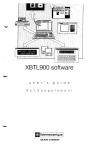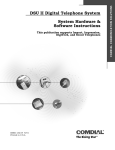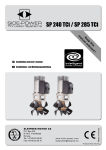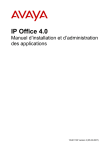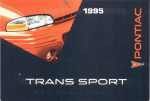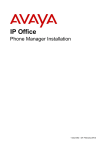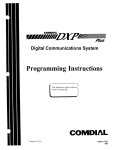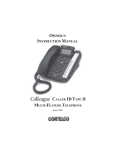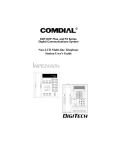Download Digi Tech CO408 User's Manual
Transcript
Digital Telephone System Attendant’s Supplement COMDWL Made rigb in the USA ’ This user guide is applicable for the following system and telephone models: System Models: CO408, C0816, and Cl632 (with software release 10 [SW 101 or later) Telephone Model: 77OOS-+*Rev. I and later 77143~++ Rev. I and later 7714X-++ Rev. I and later Table Of Contents LCD Display Abbreviations ......................... Using This Supplement .............................. Programming The Attendant Features ................ CreatingThe LCD ResponseMessages .............. Direct Inward Station Dialing ...................... Naming The SystemTelephones.................... SettingTheMusicOnHoldFeature ................ Setting The Night Transfer Of Ringing Mode ........ Setting The System Clock ........................ Station MessageDetail Accounting (SMDA) Printout .. Storing The System SpeedDial Numbers ........... System Alarm Reporting ......................... Transferring Calls To The Voice Mail System ........ Transferring RecallsTo A Secondary AttendantTelephone........................... Understanding The LCD Displays ................... Glossary Of Terms ................................. Index ............................................ .. . 111 iV 1 .2 .2 .6 .7 .lO .12 .14 .15 .16 .20 .22 4 .25 33 36 LW visplay Abbreviations LCD Display Abbreviations This chall I identifies the abbreviationsthat appearin your LCD display. ADIAL ALL ANS ARDL BGM BKSP BLOCK CAMP CFWD CLBK CLEAR Automatic Dial All Answer Automatic Redial Background Music Back Space Block DSS EXIT FEAT FWD G (followed HOLD Direct Station Exit Feature Forward Group Hold Camp Call Forward Call Back clear by a number) . MSG NEXT OVER P (followed PERS PREV RECALL RECON RING S (followed SAVE SDIAL SEND SET SOHVA TIMER TKMSG VAB Voice Ann. by a number) by a number) Block Select . Message Next Display Override Port Personal Previous Display Recall Reconnect Ring Tone Staticn Save Number Speed Dial Send Transfer Set Secure Off-Hook Voice Announcement Timer Take Message Voice Announce Block Voice Announce Block iV 1 Using This Supplement To help you use your attendant’stelephoneto its fullest capacity,this supplementto the-DigiTechsystemuser’s guide describesthe attendant’s telephoneandtells you how to use it. You can program specialfeatureson your telephonethat areunique to attendantstation operation. The instructionsfor programming thesefeatures areincluded in the sectiontitled l ProgrammingThe AttendantFeatures For your convenience,a display summary, a glossaryof terms and an index areincluded in the back of this supplement. The operationsectionsof the accompanyinguser’s guide define oftenusedfeaturesandprovide instructionsfor their use. Pleaserefer to the following sectionsof the user’sguide (publication GCA 70-220or GCA 70-221,provided separately)for more information about your telephone’sbasic functions: l Knowing Your Telephone b UnderstandingWhat The Lights Mean 0 Using Your TelephoneTo Answer Calls . Using Your TelephoneTo Make Calls b Using Your TelephoneTo Place Calls On Hold . Using Your TelephoneTo Transfer Calls . Using Your TelephoneFor ConferenceCalls . Using The Other TelephoneFeatures l SendingAnd Receiving Non-Verbal Messages 0 Using The Auxiliary Jack . Programming Your Telephone l Using Your Quick ReferenceGuide b TroubleshootingYour Telephone Creating The LCD Response Messages When you arebusy or are away from your desk, you can set a message at your telephonethat will be receivedby any LCD speakerphone within your system. Your systemprovidestwo default messages: “Back at . . .‘I and “Call . . .” In addition, you can addeight customized messages,or you can createup to ten messagesif you choosenot to use the two default messages. Note: If you intend to create a response message to a voice announce, remember that this is also a message, and that it uses one of your message locations. To store the LCD messages,proceedas follows: write your messageson the chart on page5 (eachmessagecan have up to 16 characters), usethe letter code table (on page4) to assigna number to eachletter, write thesenumbers on the chart line besidethe messageletters, pressITCM, dial+##O 5, dial a messagelocation number (l-O), dial # to clear currentmessage, composeyour messagesby dialing the two-digit codesthat relate to the letters, dial +#to savemessage, dial next location number,#to clear it, two-digit codesfor the message,and +#to save, repeatprevious stepuntil all messagesare stored, pressSPKR to end. Example: Createa messagethat will readas “TAKE MESSAGE” and program it into messagelocation number 3. - pressITCM, dial + # 0 5, - dial 3 #, - dial +1,11,22,22 12 61, 32,73, 73;21,41 32 space M E S S A G’E - dial #, and pressSPKR to end. 2 rrvgrarrrrnmg I rie fmzrmmr rearures When you arefinished creatingandprogramming messages,fill in the list on page5 of this guide. Make a list of the storedmessagesand their location numbers,and give eachstationuser a copy. 00 00 00 00 00 00 0 ,SPKR Button 0 @---pg @@@ 0 0 000000 I 000000 000000 Im 0 0 0 Antercom Light 0 Y muI Continued 3 -ITCM Button on the following page . rrvyrarrmmy I ne menaanl tearures Letter Code Table 4 LCD Message List 5 rrvyra 111,111, ,y IIICirl~1GIIUCIIII rGcJ,“IGa Direct Inward Station Dialing The direct inward station dialing (DISD) featureallows an external party to call an intercom station directly without assistancefrom the attendantif the call is made over a line programmedfor that purpose. As the system attendant,you may instruct callers to make DISD calls when necessary. For example,if a caller regularly dials a number that rings at the attendant’sstation for service,you may give the caller the DISD line number and the extensionnumber associatedwith the station he is trying to reach. Future calls from the caller to a specific party will not have to be serviced at the attendant’sstation,althougha ring-no answer or busy condition at the called party’s station will result in the system’s handling the call in anothermanner(describedbelow). When a caller makes a DISD call from an outsideline, he or shewill initially hearringing. The systemwill answerthe call with a DISD continuous dial tone; the caller can then dial an extensionnumber. - If called station is idle, a tone is soundedand called station rings. - If the call is answered by another station user, the caller can ask for transferto desiredstation. - If ringing stops anddial tonesoundsagain,the caller can dial another extensionnumber. - If called station has callforward featureset,forward station rings. - If calied’station is busy, call is placedon hold and camped-onat busy station. If camp-on is not answered within a transfer recall timeout period, busy tone is given, followed by a DISD dial tone. Note: The system will return the caller to DISD dial tone two additional and then drop the line. times - If called station is busy but ispartof a huntgroup, DISD call is routed to idle stationin hunt group,if available;otherwise,the call is campedon at dialed station. Hunt group is not followed when caller hears ringing but receivesno answer. - If an invalid extension number is dialed, an error tone is sounded before DISD dial tone is returned(caller can redial). If mistake in dialing is made, caller can dial +Kfor new DISD dial tone. Note: The system will return the caller to DISD dial tonetwo additional and then drop the line. times - If extension number dialing is not completed within the programmed dial time limit, call is routed to DISD assist station if available; otherwise,the line is dropped. 6 Naming The System Telephones If you have an LCD speakerphone,this featurelets you know who is calling you. You can assigneither a personalname or a group name to eachsystem telephone. This name canbe up to sevenletters in length and will showup in the user’s display and/orin the called party’s display. Typical namescould be SRVC, MKTG 1, K SMITH. Name the systemtelephonesas follows: l useletter codetable (page8) to composenamesfor all telephones requiring them (up to sevenlettersper name is allowed), l pressITCM, l dial%#OO, l dial the station number of the telephoneto be named (lo-57), l dial # to clear currententry, l dial two-digit codesthat correspondto letters in name, l dial +l+to continue enteringstationnames(repeatabovesteps beginning with station selectionlo-57), l pressSPKR to end, l recordnameson page9. 7 Letter Code Table I E 132 H 1 42 L M N 0 P 53 61 62 63 71 11 72 73 Q R S 1 8 Station Names (Record telephone names here. Copy this sheet if you need more record space.) 9 rrvyrdrrrrrrrrry I IICZ rl,LlG,I”clll‘ rGa‘“,Ga Setting The Music On Hold Feature Music that is provided to outsidelines while thoselines are on hold can be enabledand disabledthroughthe attendant’sstation: TC 3 set the music on hold feature, l pressITCM, l dial+%#OO, l pressA 1 (top, left-hand programmablebutton) to alternatethe featureon and off, q l l dial 1 to enable, dial 2 to disable, Note: Associated light will turn on when music on hold is provided and turn off when the feature is disabled, l pressSPKR to end. 10 rrvyrarrrrr~~r~y I IIG ~~uziiucuit rci’diuiea -Al / 000000 0-o--r I 000000 0000-0~ tm 11 1 IlO *c# 1-O - SPKR Button / ITCM Button rrogrammlng I ne Hrrenaanr Pearures Setting The Night Transfer Of Ringing Mode day (or normal) ringing assignmentsof incoming lines can be transferred to a particular station or stationsfor off-hour or specialpurpose answering(suchline/station ringing assignmentsaremade through class of serviceprogramming). Additionally, stationscan be arranged through classof serviceprogramming to answerany ringing outside line. The ability to answera line from any station is also enabled through the night transferof ringing mode. The To set the night transfermode, l pressITCM, l dial+#OO, l pressAl (top, left-hand programmablebutton) to alternatethe feature betweenon and off, q l l Note: l dial 1 to enable, dial 2 to disable, Associated light will turn on when night tran&er when the feature is disabled. is active and will turn off pressSPKR to end. BecauseNight Transfer is a commonly usedfeature,you may wish to program a button to serveasthe Night Transferbutton. To do this, l pressITCM, l dialS+l, l pressone of the programmablebuttons, l pressITCM, l dial+k#OO, l pressSPKR to end. To set the Night Transfer Of Ringing mode, simply pressthe Night Transfer button you’ve programmed. To return ringing to the attendant’sstation,pressthe Night Transferbutton again. 12 ..: I // -Al mcmcn 00 00 00 00 00 00 00 * # 4 1-o - SPKR Button / ITCM Button j ._ :: : 73 Setting The System Clock The system clock can be programmedto maintain currentdate andtime information. This information is providedto the LCD speakerphone for display. To set the systemclock from the attendant’sstation, l pressITCM, l dial*#Ol, l dial two digits (00-99)for year, l dial two digits (01-12)for month, l dial two digits (01-31)for day, l dial two digits (00-23) for hour, l dial two digits (00-59) for minutes, l pressSPKR to end. r* 14 Station Message Detail Accounting (SMDA) Printout If your system is connectedto a printer, you can command the system to print severaldifferent typesof reportsand to deleteall storedSMDA records. To print an SMDA report, l pressITCM, l dial*#OO, l choosereport to be printed: - dial 1 # for stationreport - dial 2 # for line report - dial 3 # for SMDA departmentreport - dial 4 # for accountcodereport - dial 5 # for automaticreports - dial 6 #to print all records. - dial 7 #to deleteSMDA records - dial 0 # for DepartmentalCall Distribution (DCD) report - dial 8 to obtain the number of free recordsremaining in the system (appearsin LCD display) - dial 9 to abortprinting l pressSPKR to end. ;j..’ : .: Storing The System Speed Dial Numbers You can storeup to 99 systemspeeddial numbers at your attendant telephonethat every system usercan accessfrom his or her telephone. Typically, thesearenumbersthat are frequently called by many different usersandemergencynumbersthat you want readily available to everyone. Distribute a list of thesestorednumbersto the systemusers for their reference. To program system speeddial numbersfrom the attendant’sstation, l pressITCM, l dial%# 02. l dial 01 - 99 to choosestoragelocation, l dial # to clear current entry, a chooseline that is to be used: - dial 90 for no line assignment(systemwill chooselast line used at calling station or prime line if one is assignedto calling station), q - pressbuttons Al - Al4 for lines 1-14or dial 01 - 14, q - pressbuttonsBl, B2 for lines 15, 16 or dial 15,16, q - -,,s;FOLD - 9 then pressbuttonsAl - A8 for lines 17 - 24 or dial q - dial 91- 94 for line groups 1 - 4, q l l l l pressITCM for intercom line, dial the number to be stored(32 digits maximum), - pressHOLD to storepause(if required), - pressTAP to store flash (if required), pressTRANS/CONF to savenumber, repeatabovesteps(beginningwith choice of storagelocation) to storenext number, pressSPKR to end. 76 -Al-A14 -TAP Button / B2BlHOLD Bull-ON ‘c \,L Il\O\O 0 L ~000000, 000000’ \ lm 0 0 ml, AW41’ 17 1-O - SPKR Button / ITCM Button 0 I *E# : Programming The Attendant Features System Speed Dial Numbers (Record system speed dial here. Copy this sheet if you need more record space.) 18














































